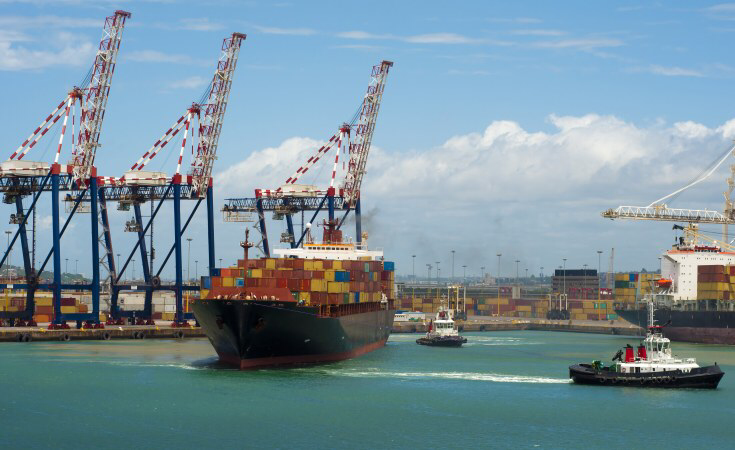
The Port of Durban, the largest and busiest shipping terminal in sub-Saharan Africa.
The African Continental Free Trade Area (AfCFTA) could reduce COVID-19-induced growth contraction, poverty and inequality trends and spur sustainable and inclusive growth on the continent if stronger support measures targeting women, young traders and small businesses are implemented, according to UNCTAD’s Economic Development in Africa Report 2021 published on 8 December.
The report shows that trade policies alone are unlikely to support inclusive economic growth on the continent. Other measures needed to increase potential distributional gains from regional integration and help ensure inclusive development are cooperation in promoting investment and competition policies, accelerating financing of infrastructure that facilitates rural-urban linkages and providing equal access to socioeconomic opportunities and productive resources.
The AfCFTA, under which free trade officially commenced in January 2021, is one of the flagship projects of the African Union’s Agenda 2063, which includes various targets on sustainable and inclusive growth. Economic growth can only be inclusive if it reduces both poverty and inequality, the report says.
“The AfCFTA has immense potential to spur economic growth and transform the continent’s development prospects if additional measures are taken to realize and fairly distribute its many potential benefits, as these gains will not come automatically,” said UNCTAD Secretary-General Rebeca Grynspan.
“Poverty and inequality are not inescapable. They are products of political choices and public policy. This report will support African governments and development partners to better leverage the AfCFTA to tackle both poverty and inequality to ensure the expected gains from free trade are more inclusive.”
Inclusive growth elusive for most African countries
According to the report, growth has been inclusive in only 17 out of 49 African countries for which sufficient household data for between 2000 and 2020 is available. Africa’s economic growth has been poverty-reducing, the report says, but inequality-increasing in 18 African countries and non-inclusive on either dimension in 14 nations.
This finding raises the key question of how economic growth through regional integration can contribute to poverty reduction and foster inclusive development, a main objective of Agenda 2063.
Africa’s unprecedented growth in the 2000s has not translated into significantly improved livelihoods for most Africans, as the income gap between the rich and the poor has widened. About 34% of African households live below the international poverty line ($1.9 per day), and around 40% of the total wealth is owned by approximately 0.0001% of the continent’s population, according to the report.
The COVID-19 pandemic has exacerbated inequalities and vulnerabilities of marginalized groups, resulting in an additional 37 million people in sub-Saharan Africa living in extreme poverty (at the poverty line of $1.9 per day).
Intra-African trade can create inclusive growth
The report says trade liberalization, whether bilateral, regional or multilateral, entails some losses of tariff revenues and has redistributionaleffects. However, more international trade can also generate interregional knowledge spillovers, which could increase efficiency, diffuse technology and redistribute wealth.
Intra-African trade is currently low at 14.4% of total African exports. It’s comprised of 61% processed and semi-processed goods, suggesting higher potential benefits from greater regional trade for transformative and inclusive growth, the report finds.
The report emphasizes that when considering informal cross-border trade, Africa records higher intra-regional trade, particularly in agriculture.
Informal cross-border trade can account for up to 90% of official trade flows in some countries and contribute to up to 40% of total trade within regional economic communities such as the Southern African Development Community (SADC) and the Common Market for Eastern and Southern Africa (COMESA).
It also functions as an employer of last resort for many vulnerable groups, making it an important source of income for the poorest segment of the population and marginalized groups like women and the youth.
An untapped $22 billion opportunity
The report finds that the continent’s current untapped export potential amounts to $21.9 billion, equivalent to 43% of intra-African exports. It says an additional $9.2 billion of export potential can be realized through partial tariff liberalization under the AfCFTA over the next five years.
To unlock the untapped potential, various intra-African non-tariff barriers, including costly non-tariff measures, infrastructure gaps and market information gaps, need to be successfully addressed. This requires joint efforts under the AfCFTA.
Long-term cooperation in investment and competition policies will be essential to overcoming market dominance by a few actors and to reducing structural and regulatory barriers to market entry.
Due to border closures induced by the COVID-19 pandemic, vulnerable groups such as women cross-border traders, small businesses and informal trades have experienced a complete depletion of their savings and have struggled to provide necessities for their families, the report says.
“Complementary measures to support women and young people in trade, small businesses and the least developed African countries are required to achieve a more inclusive AfCFTA,” said WamkeleMene, Secretary-General of the AfCFTASecretariat.
Allafrica.com
 Africa -China Review Africa -China Cooperation and Transformation
Africa -China Review Africa -China Cooperation and Transformation